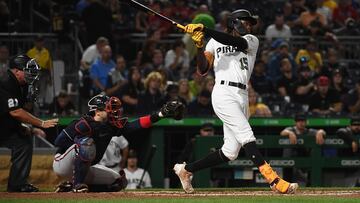Was Oneil Cruz’s 122.4 mph hit the hardest ever in MLB?
Cracking a rocket at 122.4 mph off the right field wall, Oneil Cruz has the hardest hit in the Statcast era, but what does that mean exactly?

The Pittsburgh Pirates have a shortstop in Oneil Cruz who now holds two distinctions in baseball. He has the hardest throw by an infielder at 97.8 mph and the hardest hit ball at 122.4 mph that have ever been recorded. But just what does that mean exactly?
For a start, let me be clear that this is not meant to undermine Cruz in any way. 122.4 mph is fast, any way that you cut it. It is 45 mph faster than a fully mature cheetah, for example. Storm Eunice, which battered the UK earlier this year, had wind gusts that hit 122 mph. It is roughly the same speed as terminal velocity, or the maximum speed that a human will reach when they fall through earth’s atmosphere. It is pretty close to the flat-out top speed of a Honda Civic.
But when a record-breaking event comes along, it is always accompanied by the phrase “in the Statcast era”. Statcast, for the uninitiated, is a two-camera system backed up by a serious amount of computational power which collate a staggering amount information about every pitch, every hit, every play of every baseball game in the major leagues. And it has been around for six years.
That is what “the Statcast era” is. Six years. To be fair, we are in the middle of the seventh season, so the Statcast era is set to grow by nearly 17%.
The issues surrounding Statcast, that it has trouble tracking slightly more than 10% of batted balls, that it displays a ballpark bias in exit velocity recordings, that it is only accurate on ball distances to within about a foot, have been around since the beginning of its use, and while they are still significant issues, the real question is how only six years can be described as an era.
Let’s take a typical Statcast anomaly as a reference example. Prior to 2017, pitch speed was measured at a defined spot, typically 55 feet from home plate. In the 70s, pitch speed was measured just in front of the plate. Statcast measures the fastest point on the ball’s trajectory, which is generally the instant it leaves the pitcher’s hand. Pitchers in the past six years have seemed to be anywhere between 0.5 and 0.7 miles per hour faster than pre-2016 due entirely to this change in how, and where, they are measured.
Of course, we are talking about small differences, fractional differences, but when you have records measured on fractions of a second, or fractions of a foot, or even fractions of a mile per hour, then you have to be a bit cautious with the weight given to that kind of information.
The same goes for all of the other troubling issues with Statcast data. Was a 421-foot home run really 421? Or was it 420? Or even 422, for that matter? Was one correct and another off, or were both off in different directions? And of course, these are only the issues with the accuracy of the data collected by Statcast, we haven’t even touched on the nature of the data. Questions like why it is important to see someone hit hard rather than well, for example, require another essay, all their own.
All of this brings us back to Oneil Cruz. He hit a bullet off the right field wall, to be sure. Hard line-drives have been a mainstay of the game for well over a century and a half. Was his the hardest ever? Who knows, is the short answer. It was impressive, but not overly so until Statcast popped up with the data indicating that it was the hardest they had ever measured.
Given that it clocked at 0.2 mph faster than the next two hits, and just one mile per hour faster than the top five, there is ample room to question the accuracy of the measurement in the first place. But more glaringly, there is the looming issue before us that all of these measurements are only six years old.
Was it harder than Yangervis Solarte’s shot against the Mets in 2014? What about Desmond Jennings’ bomb against the Red Sox that same year? Or anything by any of the great power hitters from Barry Bonds all the way back to Shoeless Joe Jackson? It is impossible to say. None of these players, that is to say over 99% of all professional baseball, fall within “the Statcast era.”
What we can say with certainty is that Oneil Cruz has hit the hardest ball that we have seen in a few years, and that is going to have to be good enough, for now.






